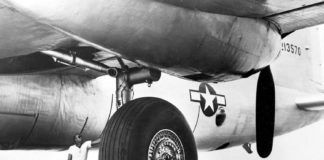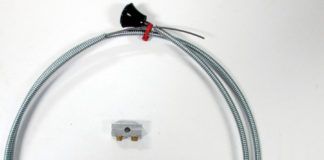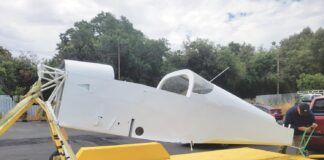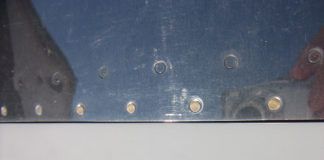I got the builder bug sometime in the 1990s, but not being a pilot and not knowing the first thing about airplane design, I went into a holding pattern while I tried to sort it all out. Along the way I heard aboutlocal EAA chapter meetings, and figured they might be a source for both inspiration and information. At one of these meetings I met a retired airline captain, Rex. He was interested in flying small planes, but far from certain he wanted to build one.
Well, I was in this holding pattern with my flying/airplane thing until, one day, Rex went down to Oregon and happened to stop at Vans Aircraft. While there, Rex got a test ride in the RV-9A, liked the plane a lot, and came home to tell me about it. Near as I could figure, the RV-9A was exactly what I needed. Rex and I signed a joint ownership agreement, placed an order with Vans, and received the empennage kit in December 2001. We then spent the next 30 months working on the kit; 2700 hours later we were ready for the inspection and sign-off. Done! Finished! Lets fly.
Hang on There, Laddie
There’s that word, finished, again. It plays into this story in a big way. After the first year and a half of kit building, it was time to deal with the instrument panel. Rex learned to fly with the Wright brothers, I think, so he was partial to those funky round instruments that looked like they came from a discarded Model A Ford. I, on the other hand, was now learning to fly, and my instrument panel experience was contemporary.
So the first instrument panel decision: primary flight instruments. We might have followed Rexs instincts and installed a tried-and-true six-pack (Im learning the lingo). Funny thing, though. There was a guy named Doug in our EAA chapter, and he worked for a small startup company called Dynon, which was, at the time, just releasing a new “one instrument does everything” flight instrument, and it was digital! It seemed like a slam dunk. Well…almost. We did have a list of reservations. Rex had never used an EFIS. The depth of the instrument-the Dynon D10 is nearly 7 inches long behind the panel-created some interference with a secondary bulkhead. The display seemed crowded, and we had no data showing that the Dynon provided reliable flight information-and we did intend to fly this airplane.
Compromises
We solved the primary flight instrument issue by compromising. We decided to make two round holes in the instrument panel, one for a Dynon and one for a traditional round airspeed indicator. If the Dynon failed in flight, we could always land using the ASI. If the Dynon proved to be reliable, we could replace the ASI at a later date with a second Dynon. With two Dynons, we could split the displayed information and reduce the clutter-assuming clutter was a problem.
Our next panel issue was GPS, which stands for Global Positioning System, Rex. When I broached the subject, he gave me “the look,” which is what you get when your flying hours are very small compared to his flying hours, which are very, very large.
Turns out the DC-6s, 707s, DC-10s and 747s Rex flew for 30 years had no GPS instrumentation, and because Rex was still alive and kicking (that is, he survived), there was no apparent reason to add this function now. I, on the other hand, like technical things, and did not relish the 172 navigation instrumentation I was being trained on. Come on, whats exciting about a VOR?
Then there was size-screen size, that is. Back in 2003, most of the less expensive GPS screens were small, very small. You needed serious magnification in your bifocals if you wanted to see where you were going with these instruments. (If you don’t know what bifocals are, you’ll find out soon enough.) Then I found the Bendix/King KMD150. I liked its large display, and the price was tolerable, but how to convince Rex that (a) we needed it, and (b) it would be useful? I don’t remember how I pulled it off, but in the end we agreed to add it to our panel.
Beyond the Basics
The rest of the panel decisions were relatively easy. We also chose the Control Vision Exp 2 Bus DC Load Center, a crafty combination of master solenoid, circuit breaker, master switch, avionics master switch and numerous circuit switches. Lastly, we cut the panel in two with the idea that we could easily remove one part to get at the backside of the remaining part; ironically, we never used this feature.
The center panel was designed to remove some clutter from the main panel. In effect, it became an extension of the throttle cluster, connecting the instrument panel to the fuel tank switch platform. We put a dual fuel level indicator (Aerospace Logic FL-100-R) just above the fuel tank switch (logical?), the ELT just above the fuel level indicator, and the trim indicator/switch and flap switch above the ELT. This arrangement has worked well, and Id use a
center panel again, given the chance.
So there you are. We completed the plane and successfully passed inspection in May 2004. We were “finished” with the kit stuff, and it was time to go flying.
Not So Fast
In the spring of 2005 I visited Florida and dropped by a grass patch. Well, there was an RV-9A sitting in an open hangar, so I stopped, met the builder/pilot, and the next thing you knew we were off for a bit of local flying. Now his panel was OK. It had lots of round gauges, and I didn’t have the heart to tell him it was terribly old-fashioned. But he did have one round gauge I didn’t recognize: a dual-axis autopilot. (Turns out it was a TruTrak DigiFlight II.) He had installed it the previous year, and then flown his plane to Oshkosh. He claimed it was one of the more useful instruments on his panel, and all the cool planes had one.
Well, there’s a challenge for you. How was I going to go back to my plane knowing I did not have one of these cool things? What would Rex say? How would I get another hole in our panel? Lots of questions. We found a few simple answers, and after installing the servos and locating a good place in the panel we were autopilot flying in 2005.
Nope, Still Not Done
Thought we were finished! Turns out there are some devious people in the airplane instrumentation business. I mean, they sell you instruments for your plane knowing full well there’s something better germinating in their back room that will make your hard-earned purchase outdated. This means the panel you’ve worked so hard to lay out and complete could well be obsolete by the time you take your first flight! That is so not fair.
The first inkling that we had a problem came in a 2006 advertisement from Dynon showing the new EFIS-D100, which has a 7-inch display. Of course, this happened just about the time we had convinced ourselves that flying with the 4-inch display was all one would ever need. All of a sudden the 4-inch display seemed crowded, and there could be a safety issue. Think of it, the sun is shining, thermals absent, no traffic in sight, and its time to make a critical in-flight decision. You look at your EFIS…time is of the essence, and you need to read that display correctly the first time. You get confused. Clearly, a 7-inch display is needed. Its a “safety thing” you tell yourself (and your partner, and your spouse).
But Heres the Problem
Well, there was no room for the new 7-inch Dynon in the current panel. To add to the confusion, Vision Microsystems has had the audacity to update its black-and-white VM1000, which we thought we were happy with, for a color display with additional features, including fuel level indicators.
If we were to add the new VM1000C, that would obsolete the fuel level indicator on our center panel! And everyone knows airplanes wont fly straight with a hole in the panel, not to mention the “safety thing.”
So, after two and a half years of flying and 250 hours on the Hobbs, we had yet another decision to make. Heres where creative accounting plays out. If you do your cost analysis right, its possible to show that the purchase of (a) three new instruments (Dynon D100, VM1000C and a clock to fill the hole), (b) a blank panel, (c) a Solid Works layout, and (d) machine shop charges for cutting the panel are easily justified by the resale of used instruments (assuming grossly inflated prices) and the safety thing. Decision made.
Time for a panel redesign. Im guessing here, but Ill bet Van laid out his fuselage back in the days when round instruments were in. For example, there are three ribs going from the firewall to the back of the instrument panel, and all three are directly in the way if you need large cutouts for modern digital instruments. Now Im not the accusing type, but Ill bet Van also bought a large stock of round instruments back in the 70s, and hes not going to remove those pesky ribs from his designs until his stock of round instruments is sold out. Just a guess, one Dutchman to another.
But I digress. The old panel was removed and most of the panel wiring was tossed out. Much time was spent figuring out how to miss Vans ribs and still get the instruments placed where they would do the most good. We eventually arrived at a consensus, had the panel appropriately laid out and cut, had the main and center panels professionally painted (no more rattle cans!), redid the wiring and plumbing, and finished the project in May 2007. Yes, the cost for these changes came up on several occasions, and Im happy to report the safety thing and creative accounting covered our rears nicely. That leaves the finished thing. Are we finished?
Honestly, I haven’t a clue.













